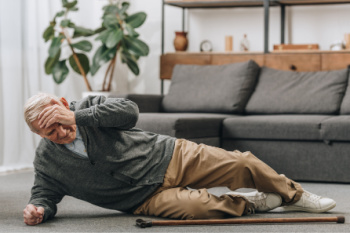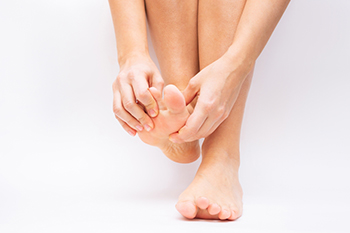Connect With Us
Blog
Items filtered by date: March 2024
Exercises Can Reduce the Risk of Falling

Exercise is an important way to reduce the risk of falling, particularly by focusing on activities that improve muscle strength, balance, posture, and stamina. Muscles naturally weaken and balance deteriorates without consistent exercise. By incorporating simple exercises into your daily routine, you can significantly increase stability and help prevent falls. Be sure to have a chair or counter nearby for safety reasons. Try standing on tiptoes, gradually transitioning to heel lifts and toe raises to improve ankle strength and balance. Side leg raises, performed by lifting one leg to the side while keeping toes forward, are excellent for strengthening hip abductors and improving lateral stability. Additionally, practicing walking in a straight line, progressing by placing one foot directly in front of the other to walking heel to toe along a counter. This can enhance overall balance and coordination. Sometimes, underlying foot or ankle issues contribute to instability. If balance issues have become a problem, it is suggested that you make an appointment with a podiatrist to address them.
Preventing falls among the elderly is very important. If you are older and have fallen or fear that you are prone to falling, consult with Jeffrey Rosenblatt, DPM from New York. Our doctor will assess your condition and provide you with quality advice and care.
Every 11 seconds, an elderly American is being treated in an emergency room for a fall related injury. Falls are the leading cause of head and hip injuries for those 65 and older. Due to decreases in strength, balance, senses, and lack of awareness, elderly persons are very susceptible to falling. Thankfully, there are a number of things older persons can do to prevent falls.
How to Prevent Falls
Some effective methods that older persons can do to prevent falls include:
- Enrolling in strength and balance exercise program to increase balance and strength
- Periodically having your sight and hearing checked
- Discuss any medications you have with a doctor to see if it increases the risk of falling
- Clearing the house of falling hazards and installing devices like grab bars and railings
- Utilizing a walker or cane
- Wearing shoes that provide good support and cushioning
- Talking to family members about falling and increasing awareness
Falling can be a traumatic and embarrassing experience for elderly persons; this can make them less willing to leave the house, and less willing to talk to someone about their fears of falling. Doing such things, however, will increase the likelihood of tripping or losing one’s balance. Knowing the causes of falling and how to prevent them is the best way to mitigate the risk of serious injury.
If you have any questions, please feel free to contact our office located in Brooklyn, NY . We offer the newest diagnostic and treatment technologies for all your foot care needs.
Staying Abreast of Diabetic Foot Ulcer Treatments

Staying informed about diabetic foot ulcer treatments is necessary for effective patient care. Common interventions include surgical debridement to remove necrotic tissue, antibiotic therapy to combat infection, and vascular assessment to optimize blood flow. Offloading pressure from affected areas is essential for healing. In severe cases, amputation may be necessary to prevent further complications. Additionally, various therapies exist for non-healing wounds, such as advanced dressing. Podiatrists play a vital role in diabetic foot ulcer management, possessing specialized education and skills in this field. By staying abreast of evolving treatments and leveraging multidisciplinary approaches, they can enhance outcomes and improve the quality of life for individuals with diabetic foot ulcers. If you suffer from diabetic foot ulcers, it is strongly suggested that you make routine appointments with a podiatrist for the best care possible.
Wound care is an important part in dealing with diabetes. If you have diabetes and a foot wound or would like more information about wound care for diabetics, consult with Jeffrey Rosenblatt, DPM from New York. Our doctor will assess your condition and provide you with quality foot and ankle treatment.
What Is Wound Care?
Wound care is the practice of taking proper care of a wound. This can range from the smallest to the largest of wounds. While everyone can benefit from proper wound care, it is much more important for diabetics. Diabetics often suffer from poor blood circulation which causes wounds to heal much slower than they would in a non-diabetic.
What Is the Importance of Wound Care?
While it may not seem apparent with small ulcers on the foot, for diabetics, any size ulcer can become infected. Diabetics often also suffer from neuropathy, or nerve loss. This means they might not even feel when they have an ulcer on their foot. If the wound becomes severely infected, amputation may be necessary. Therefore, it is of the upmost importance to properly care for any and all foot wounds.
How to Care for Wounds
The best way to care for foot wounds is to prevent them. For diabetics, this means daily inspections of the feet for any signs of abnormalities or ulcers. It is also recommended to see a podiatrist several times a year for a foot inspection. If you do have an ulcer, run the wound under water to clear dirt from the wound; then apply antibiotic ointment to the wound and cover with a bandage. Bandages should be changed daily and keeping pressure off the wound is smart. It is advised to see a podiatrist, who can keep an eye on it.
If you have any questions, please feel free to contact our office located in Brooklyn, NY . We offer the newest diagnostic and treatment technologies for all your foot care needs.
Causes of Big Toe Stiffness

The big toe, or hallux, is more than just a digit on your foot. It's essential for your daily activities, like walking, standing, and maintaining balance. However, stiffness in the big toe can severely impact mobility and comfort. Big toe stiffness, medically known as hallux rigidus, can stem from various factors. Most cases are of unknown origin, while others result from injuries damaging the joint's cartilage. Structural changes, like a shifted or bent first metatarsal, or even genetic predispositions, can contribute to its development. Additionally, conditions such as osteoarthritis, gout, or bunions can increase the risk of big toe stiffness. Pain, swelling, and redness around the joint, along with stiffness and reduced range of motion, are common symptoms. If you're experiencing symptoms of big toe stiffness, it's suggested that you make an appointment with a podiatrist, who can offer the appropriate treatment option.
Toe pain can disrupt your daily activities. If you have any concerns, contact Jeffrey Rosenblatt, DPM of New York. Our doctor can provide the care you need to keep you pain-free and on your feet.
What Causes Toe Pain?
Most severe toe pain is caused due to a sports injury, trauma from dropping something heavy on the toe, or bumping into something rigid. Other problems can develop over time for various reasons.
Toe pain can be caused by one or more ailments. The most common include:
- Trauma
- Sports injury
- Wearing shoes that are too tight
- Arthritis
- Gout
- Corns and calluses
- Hammertoe
- Bunions
- Blisters
- Ingrown toenails
- Sprains
- Fractures (broken bones)
- Dislocations
When to See a Podiatrist
- Severe pain
- Persistent pain that lasts more than a week
- Signs of infection
- Continued swelling
- Pain that prevents walking
Diagnosis
In many cases the cause of toe pain is obvious, but in others, a podiatrist may want to use more advanced methods to determine the problem. These can range from simple visual inspections and sensation tests to X-rays and MRI scans. Prior medical history, family medical history, and any recent physical traumatic events will all be taken into consideration for a proper diagnosis.
Treatment
Treatments for toe pain and injuries vary and may include shoe inserts, padding, taping, medicines, injections, and in some cases, surgery. If you believe that you have broken a toe, please see a podiatrist as soon as possible.
If you have any questions please feel free to contact our office located in Brooklyn, NY . We offer the newest diagnostic tools and technology to treat your foot and ankle needs.
Types of Stress Fractures From Running

One significant risk facing runners is the potential for stress fractures, which are hairline cracks in one of many bones in the feet. Metatarsal stress fractures often occur in the 2nd or 3rd metatarsals, due to their structure and the forces exerted during running. Pronation can add to the amount of stress on these bones. Navicular stress fractures can be recognized as midfoot pain on the outside of the foot. This type of fracture is more common in runners with flat feet or those engaged in track and field or middle distance running. Calcaneus stress fractures cause heel pain, especially during weight-bearing activities. They are often the result of increased training intensity or frequency. Stress fractures in the big toe are most often found in the bone closest to the first metatarsal. These fractures occur due to repetitive loading during running, resulting in localized pain and swelling around the first metatarsophalangeal, or MTP, joint. If you have pain in your feet that may be the result of running, it is suggested that you schedule an appointment with a podiatrist for an exam and diagnosis.
Activities where too much pressure is put on the feet can cause stress fractures. To learn more, contact Jeffrey Rosenblatt, DPM from New York. Our doctor can provide the care you need to keep your pain free and on your feet.
Dealing with Stress Fractures of the Foot and Ankle
Stress fractures occur in the foot and ankle when muscles in these areas weaken from too much or too little use. The feet and ankles then lose support when walking or running from the impact of the ground. Since there is no protection, the bones receive the full impact of each step. Stress on the feet can cause cracks to form in the bones, thus creating stress fractures.
What Are Stress Fractures?
Stress fractures occur frequently in individuals whose daily activities cause great impact on the feet and ankles. Stress factors are most common among:
- Runners
- People affected with Osteoporosis
- Tennis or basketball players
- Gymnasts
- High impact workouts
Symptoms
Pain from the fractures occur in the area of the fractures and can be constant or intermittent. It will often cause sharp or dull pain with swelling and tenderness. Engaging in any kind of activity which involves high impact will aggravate pain.
If you have any questions please feel free to contact our office located in Brooklyn, NY . We offer the newest diagnostic and treatment technologies for all your foot and ankle needs.
Heel Pain Can Be Treated!
Blog Archives
- October 2025
- September 2025
- August 2025
- July 2025
- June 2025
- May 2025
- April 2025
- March 2025
- February 2025
- January 2025
- December 2024
- November 2024
- October 2024
- September 2024
- August 2024
- July 2024
- June 2024
- May 2024
- April 2024
- March 2024
- February 2024
- January 2024
- December 2023
- November 2023
- October 2023
- September 2023
- August 2023
- July 2023
- June 2023
- May 2023
- April 2023
- March 2023
- February 2023
- January 2023
- December 2022
- November 2022
- October 2022
- September 2022
- August 2022

